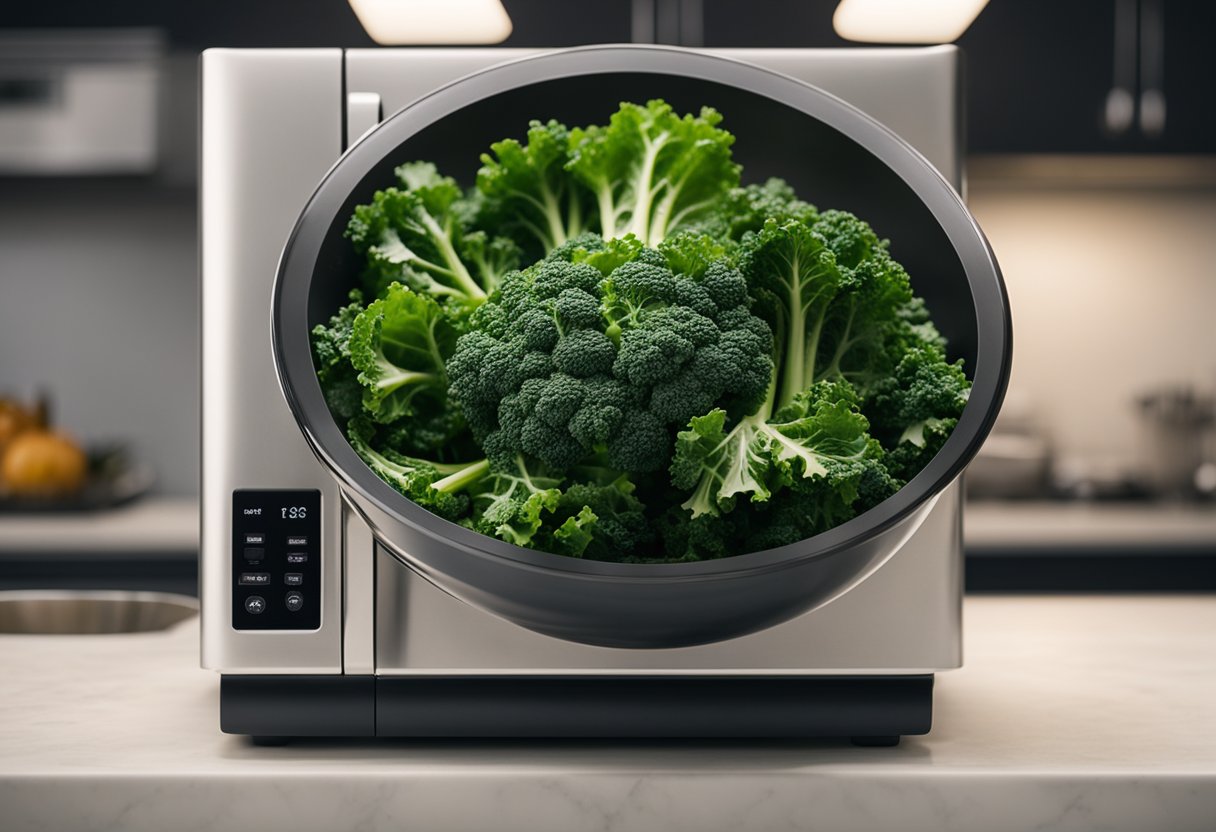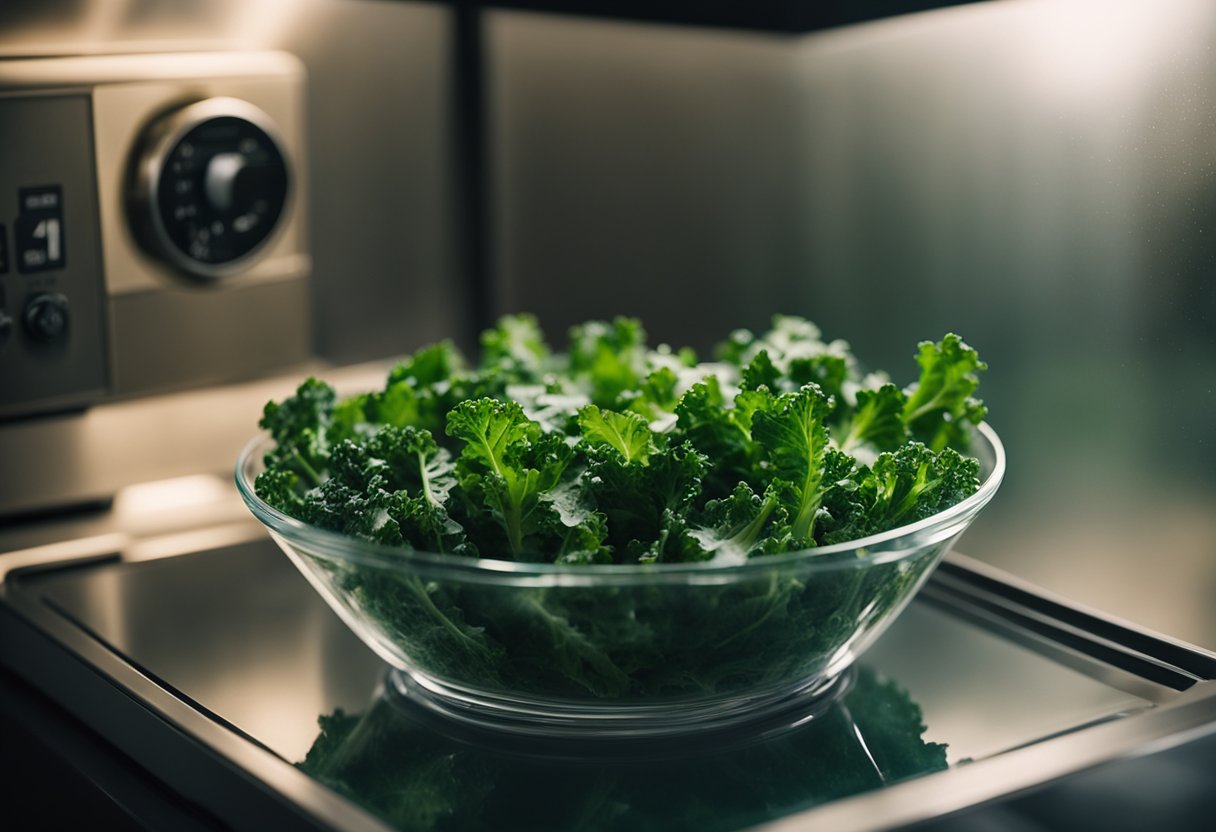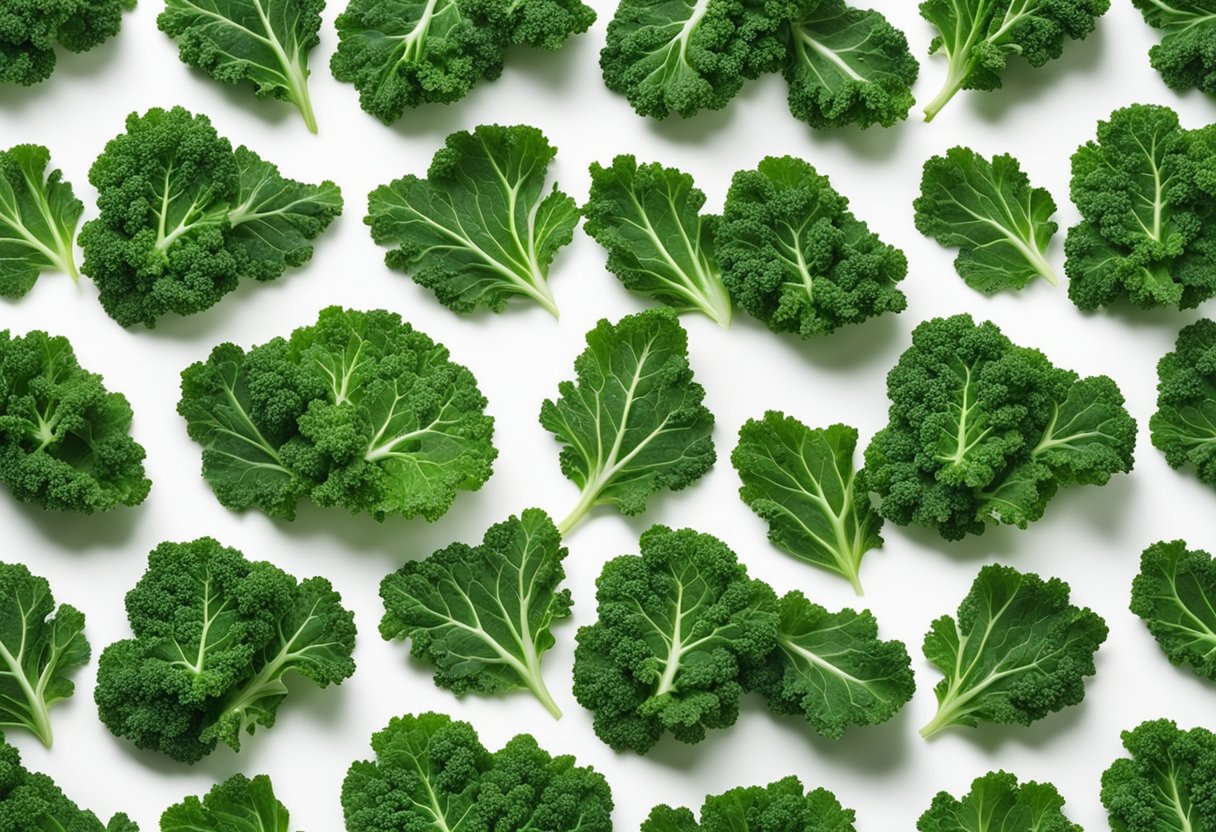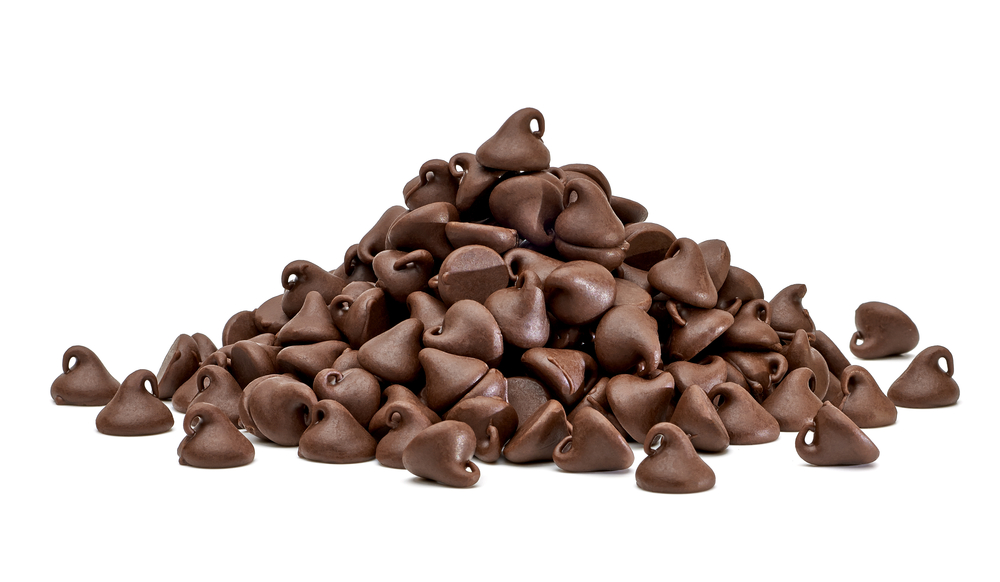I’ve done some research on whether or not you can cook kale in the microwave, and the answer is yes! Not only is it safe to do so, but it’s also a quick and easy way to prepare this nutritious leafy green.
Microwaving kale is a great option for those whoMaking Kale Chips in the Microwave are short on time or don’t want to heat up their kitchen with the stove.

Kale is a superfood that’s packed with vitamins and minerals, making it a great addition to any diet. It’s also incredibly versatile and can be used in a variety of recipes, from salads to smoothies to soups.
However, cooking kale can sometimes be a bit tricky, as it can become tough and bitter if not prepared properly.
That’s where the microwave comes in – it allows you to cook kale quickly and evenly, without the risk of overcooking or burning it.
Key Takeaways
- Yes, you can cook kale in the microwave, and it’s a safe and easy way to prepare this nutritious leafy green.
- Microwaving kale is a great option for those who are short on time or don’t want to heat up their kitchen with the stove.
- Kale is a versatile superfood that can be used in a variety of recipes, and cooking it in the microwave allows you to prepare it quickly and evenly.
Understanding Kale

Kale is a leafy green vegetable that is a member of the cabbage family. It has a slightly bitter taste and is commonly used in salads, smoothies, soups, and stir-fries.
It is a nutritious vegetable that is low in calories and high in vitamins and minerals.
One cup of raw kale contains approximately 33 calories, 2.9 grams of protein, 2.6 grams of fiber, 133% of the daily recommended value of vitamin A, 134% of the daily recommended value of vitamin C, 684% of the daily recommended value of vitamin K, 9% of the daily recommended value of calcium, and 10% of the daily recommended value of folate.
Kale is a highly nutritious vegetable that is packed with vitamins and minerals. It is an excellent source of vitamin K, which is essential for blood clotting and bone health.
It is also a good source of vitamin A, which is important for eye health, and vitamin C, which is an antioxidant that helps to protect cells from damage.
In addition to vitamins and minerals, kale is also a good source of fiber, which is important for digestive health. It is also low in calories, making it a great choice for those who are trying to lose weight or maintain a healthy weight.
Overall, kale is a highly nutritious vegetable that is an excellent addition to any diet. It is packed with vitamins and minerals, high in fiber, and low in calories. Whether you prefer it raw or cooked, it is a great choice for a healthy and nutritious meal.
Microwave Cooking Basics
Microwave cooking is a fast and convenient way to prepare food. It’s perfect for busy people who don’t have a lot of time to spend in the kitchen.
Microwaves work by using electromagnetic waves to heat up the food. They are designed to be easy to use and can save you a lot of time.
When cooking in the microwave, it’s important to use microwave-safe containers and plates. These containers are specially designed to withstand the heat and won’t melt or break.
Always check that the container you are using is labeled as microwave-safe before putting it in the microwave.
Microwave cooking times vary depending on the type of food you are cooking and the power of your microwave. Most microwaves have a power setting of 600-1200 watts.
The higher the wattage, the faster your food will cook. Always follow the cooking time instructions on the packaging or recipe to ensure your food is cooked properly.
Microwave cooking is a convenient way to prepare meals quickly. It’s perfect for busy people who don’t have a lot of time to spend in the kitchen.
With the right containers and cooking times, you can cook a variety of foods in the microwave.
How to Cook Kale in the Microwave
I have found that cooking kale in the microwave is a simple and easy way to prepare this leafy green vegetable. Here are the steps I follow to cook kale in the microwave:
- Wash and clean your kale.
- Chop the kale into bite-sized pieces.
- Place the kale in a microwave-safe bowl.
- Add a tablespoon of water to the bowl.
- Cover the bowl with a microwave-safe lid or a damp paper towel.
- Microwave the bowl on high for 2-3 minutes.
- Remove the bowl from the microwave and carefully remove the lid or paper towel.
- Stir the kale and check to see if it is cooked to your liking. If it is not, microwave for an additional 30 seconds.
- Once the kale is cooked, season it with salt, pepper, or any other seasonings of your choice.
Cooking kale in the microwave is a quick and easy way to prepare this nutritious vegetable. You can also use microwaved kale in a variety of dishes, such as salads, soups, and stir-fries.
One thing to keep in mind when cooking kale in the microwave is to add water to the bowl before microwaving. This helps to create steam, which helps to cook the kale evenly and prevents it from drying out.
Overall, cooking kale in the microwave is a simple and easy way to prepare this nutritious vegetable. It’s a great option if you’re short on time or don’t want to use the stove.
Seasoning and Flavoring Microwave Kale
When it comes to seasoning and flavoring microwave kale, the possibilities are endless. Here are some ideas to get you started:
Olive Oil and Pepper
One of the simplest ways to season microwave kale is with a drizzle of olive oil and a sprinkle of black pepper.
This combination adds a subtle, savory flavor to the kale without overpowering it. To season your kale this way, simply drizzle a small amount of olive oil over the kale and toss to coat.
Then, sprinkle some black pepper over the top and microwave as directed.
Lemon Juice and Garlic
For a brighter, more complex flavor, try seasoning your microwave kale with lemon juice and garlic. To do this, squeeze fresh lemon juice over the kale and add some minced garlic.
Toss to coat and microwave as directed. The lemon juice adds a tangy, citrusy flavor, while the garlic adds a pungent, savory note.
Sea Salt and Spices
If you want to add some depth and complexity to your microwave kale, try seasoning it with sea salt and spices. You can use any spices you like, such as paprika, cumin, or chili powder.
Simply sprinkle the spices over the kale and add a pinch of sea salt. Toss to coat and microwave as directed. This seasoning combination adds a bold, flavorful kick to the kale.
Remember, when seasoning microwave kale, less is often more. You don’t want to overpower the natural flavor of the kale with too many seasonings.
Start with a small amount of seasoning and add more as needed. With a little experimentation, you’ll find the perfect seasoning combination for your microwave kale.
Cooking Other Forms of Kale
In addition to microwaving kale, there are several other ways to cook this leafy green. Here are some methods that I have found to be effective:
Raw Kale
Raw kale is a popular ingredient in salads and smoothies. To prepare raw kale, wash and dry the leaves, remove the tough stems, and chop the leaves into bite-sized pieces. You can then add the kale to your salad or smoothie.
Sauté Kale
Sautéing kale is a quick and easy way to cook this vegetable. To sauté kale, heat some olive oil in a pan over medium heat.
Add chopped kale to the pan and sauté for a few minutes until the kale is wilted. Season the kale with salt and pepper to taste.
Frozen Kale
Frozen kale is a convenient option for those who don’t have access to fresh kale or who want to save time.
To cook frozen kale, simply thaw the kale in the refrigerator overnight or in the microwave for a few minutes. You can then use the thawed kale in your favorite recipes.
Chopped Kale
Chopped kale is a versatile ingredient that can be used in a variety of dishes.
To chop kale, remove the tough stems and chop the leaves into small pieces. You can then add the chopped kale to soups, stews, or casseroles.
Sautéed Kale
Sautéed kale is a delicious side dish that pairs well with a variety of main courses. To sauté kale, heat some olive oil in a pan over medium heat.
Add chopped kale to the pan and sauté for a few minutes until the kale is wilted. Season the kale with salt and pepper to taste.
Overall, there are many ways to cook kale, and each method has its own unique benefits. Whether you prefer microwaving, sautéing, or using raw kale in your dishes, there are plenty of options to choose from.
Alternative Cooking Methods
While microwaving is a quick and easy way to cook kale, there are other cooking methods that you can use to prepare this nutritious vegetable. Here are a few alternative cooking methods that you might want to try:
Oven
If you prefer crispy kale chips, baking your kale in the oven is a great option. Preheat your oven to 350 degrees Fahrenheit.
Remove the kale leaves from the stems and tear them into bite-sized pieces. Toss the kale with a little bit of olive oil and your favorite seasonings.
Spread the kale out in a single layer on a baking sheet and bake for 10-15 minutes, or until the edges are brown and crispy.
Steaming
Steaming is a gentle cooking method that helps to preserve the nutrients in kale. To steam kale, remove the leaves from the stems and chop them into bite-sized pieces.
Place the kale in a steamer basket or colander and set it over a pot of boiling water. Cover the pot and steam the kale for 5-7 minutes, or until it is tender.
Stir-Fry
Stir-frying is a quick and easy way to cook kale with other vegetables and proteins. Heat a little bit of oil in a wok or large skillet over high heat.
Add chopped garlic and ginger and cook for 30 seconds. Add thinly sliced kale and any other vegetables or proteins that you like, such as bell peppers, mushrooms, tofu, or chicken. Stir-fry for 2-3 minutes, or until the kale is wilted and tender.
Other Cooking Methods
There are other cooking methods that you can use to prepare kale, such as blanching, sautéing, and grilling.
Each of these methods has its own unique benefits and drawbacks, so it’s worth experimenting with them to see which one works best for you.
Kale Recipes and Uses
I love using kale in a variety of recipes. It’s a versatile ingredient that can be used in salads, soups, and as a garnish for many dishes. Here are some of my favorite kale recipes and uses:
Salads
Kale is a great addition to any salad. It’s packed with nutrients and adds a nice crunch to the mix. I like to use a mixture of kale and other greens like spinach or arugula. Here are some of my favorite kale salad ingredients:
- Dried cranberries
- Roasted almonds
- Feta cheese
- Avocado
- Grilled chicken
Soups
Kale is also a great ingredient to use in soups. It adds a nice texture and flavor to the dish. I like to use kale in vegetable soups like minestrone or in a hearty soup with sausage and beans. Here are some other soup recipes that use kale:
- Kale and white bean soup
- Potato and kale soup
- Chicken and kale soup
Side dish
Kale can also be served as a side dish. It’s a great alternative to other greens like spinach or broccoli. Here are some ways to use kale as a side dish:
- Sautéed kale with garlic and lemon
- Steamed kale with a drizzle of olive oil
- Kale chips
Garnish
Kale can also be used as a garnish for many dishes. It adds a nice pop of color and texture. Here are some dishes that can be garnished with kale:
- Grilled chicken or steak
- Roasted vegetables
- Creamy soups
Overall, kale is a versatile ingredient that can be used in a variety of recipes. Whether you’re looking for a healthy salad or a hearty soup, kale is a great addition to any dish.
Making Kale Chips in the Microwave
I love making kale chips in the microwave because it’s quick and easy. Plus, it’s a healthier way to satisfy my cravings for something crispy and salty. Here’s how I do it:
- Start by washing and drying your kale leaves. Remove the stems and tear the leaves into bite-sized pieces.
- Place the kale pieces in a microwave-safe container. Make sure they are not overlapping, so they cook evenly.
- Drizzle a little bit of olive oil over the kale pieces. You don’t need too much, just enough to lightly coat them.
- Season the kale chips with sea salt or any other seasoning of your choice. I like to use garlic powder or nutritional yeast for a cheesy flavor.
- Cover the container with a microwave-safe lid or a microwave-safe plate. This will help the kale cook evenly and prevent the oil from splattering all over your microwave.
- Microwave the kale chips on high for 2-3 minutes, depending on your microwave’s power. Keep an eye on them to make sure they don’t burn.
- Once the kale chips are crispy and golden, remove them from the microwave and let them cool for a minute or two.
- Enjoy your crispy kale chips as a healthy snack or side dish!
Making kale chips in the microwave is a great way to get your crispy kale fix without having to turn on the oven.
Plus, it’s a healthier alternative to store-bought chips that are often loaded with preservatives and unhealthy fats. Just make sure to use a microwave-safe container and cover it with a lid or a plate to prevent any oil from splattering.
Health Benefits of Eating Kale

I love eating kale because it is not only delicious but also packed with nutrients that are beneficial to my health. Here are some of the health benefits of eating kale that I have learned:
Nutrient-Dense
Kale is a nutrient-dense food, which means that it is low in calories but high in nutrients. According to Healthline, one cup of raw kale contains the following nutrients:
- Vitamin A: 206% of the Daily Value (DV)
- Vitamin K: 684% of the DV
- Vitamin C: 134% of the DV
- Vitamin B6: 9% of the DV
- Manganese: 26% of the DV
- Calcium: 9% of the DV
- Copper: 10% of the DV
- Potassium: 9% of the DV
- Magnesium: 6% of the DV
Cancer Prevention
Kale contains compounds called glucosinolates, which are converted into cancer-fighting compounds in the body.
According to a study published in the journal Cancer Prevention Research, consuming cruciferous vegetables like kale may help reduce the risk of certain types of cancer, including lung, colorectal, and breast cancer.
Anti-Inflammatory
Kale is also rich in antioxidants, which help to reduce inflammation in the body. Chronic inflammation has been linked to many chronic diseases, including heart disease, diabetes, and cancer.
Heart Health
Kale is a good source of fiber, which can help to reduce cholesterol levels and improve heart health.
According to a study published in the journal Nutrients, consuming kale may help to reduce the risk of heart disease by lowering cholesterol levels and improving blood pressure.
Overall, eating kale is a great way to boost your nutrient intake and improve your health. So next time you’re wondering what to cook for dinner, consider adding some kale to your meal!
Cleaning and Preparing Kale for Cooking

When it comes to cooking kale in the microwave, cleaning and preparing the kale is an important step to ensure that it is safe to eat and that it cooks evenly. Here are a few tips on how to clean and prepare kale for cooking in the microwave:
- Start by washing the kale thoroughly in cold water. You can rinse it thoroughly in a colander or, if it’s really gritty, put the kale in a large bowl of water and swish around until the grit is removed, and then drain. This will help remove any dirt or debris that may be on the leaves.
- After washing, it is important to dry the kale thoroughly to prevent any excess moisture from affecting the cooking process. You can use a salad spinner or pat the kale dry with paper towels.
- Once the kale is clean and dry, it’s time to prepare it for cooking. Remove the tough stems from the kale leaves by holding the stem with one hand and stripping the leaves off with the other. You can also chop the leaves into smaller pieces if desired.
- If you want to add some flavor to your kale, you can season it with salt, pepper, garlic powder, or any other seasoning of your choice. Alternatively, you can add a splash of olive oil or lemon juice to give it some extra flavor.
By following these simple steps, you can easily clean and prepare kale for cooking in the microwave. It’s a quick and easy way to enjoy this nutritious leafy green without having to spend a lot of time in the kitchen.
Understanding the Texture of Cooked Kale
As someone who loves to cook, I’ve experimented with different ways to cook kale. One thing I’ve noticed is that the texture of cooked kale can vary depending on how it’s prepared.
Kale is a leafy green vegetable that can be cooked in a variety of ways, including boiling, sautéing, and even microwaving.
When cooked, kale can become tender and flavorful, but it’s important to be aware of how cooking affects its texture.
Boiling kale can result in a softer texture, which is great for soups and stews. However, this method can also cause the kale to lose some of its nutrients.
Sautéing kale can result in a crispy texture, which is great for salads or as a side dish. Microwaving kale can also result in a crispy texture, but it’s important to be careful not to overcook it, as it can become tough and chewy.
When cooking vegetables, it’s important to pay attention to the texture, as it can greatly affect the overall taste and enjoyment of the dish.
Whether you prefer your kale soft or crispy, there are various cooking methods that can help you achieve the texture you desire.
In summary, the texture of cooked kale can vary depending on how it’s prepared. Boiling kale can result in a softer texture, sautéing can result in a crispy texture, and microwaving can result in either a crispy or tough texture if overcooked.
It’s important to pay attention to the texture when cooking vegetables to ensure a delicious and enjoyable dish.
Also, check out some similar posts:
Frequently Asked Questions
How do you cook kale in the microwave?
To cook kale in the microwave, start by washing and drying the kale leaves. Remove the stems and chop the leaves into bite-sized pieces.
Place the kale in a microwave-safe bowl and add a tablespoon or two of water. Cover the bowl with a microwave-safe lid or plastic wrap, leaving a small vent for steam to escape.
Microwave on high for 2-3 minutes, or until the kale is wilted and tender.
How long should you microwave kale for?
The length of time you should microwave kale for depends on the wattage of your microwave and the amount of kale you are cooking.
Generally, microwaving kale for 2-3 minutes on high power should be sufficient. However, if you are cooking a large amount of kale or have a lower wattage microwave, you may need to increase the cooking time.
Is it safe to cook kale in the microwave?
Yes, it is safe to cook kale in the microwave as long as you follow proper cooking techniques. Make sure to use a microwave-safe bowl and cover it with a microwave-safe lid or plastic wrap.
Leave a small vent for steam to escape and be careful when removing the bowl from the microwave, as it may be hot.
What are some tips for cooking kale in the microwave?
To ensure that your kale cooks evenly and stays moist, add a tablespoon or two of water to the bowl before microwaving.
You can also add seasonings like salt, pepper, and garlic powder for extra flavor. Be sure to stir the kale halfway through cooking to ensure that it cooks evenly.
Can you make kale chips in the microwave?
While it is possible to make kale chips in the microwave, they may not turn out as crispy as oven-baked kale chips. To make kale chips in the microwave, wash and dry the kale leaves and remove the stems.
Tear the leaves into bite-sized pieces and place them on a microwave-safe plate. Microwave on high for 3-4 minutes, or until the kale is crispy.
How do you cook kale so it’s not tough in the microwave?
To cook kale so it’s not tough in the microwave, make sure to remove the tough stems and chop the leaves into bite-sized pieces.
Add a tablespoon or two of water to the bowl before microwaving to create steam and keep the kale moist. Be sure to stir the kale halfway through cooking to ensure that it cooks evenly.







